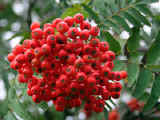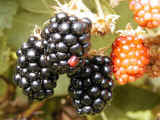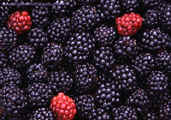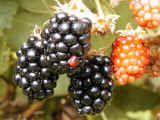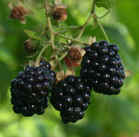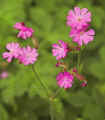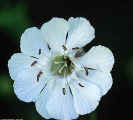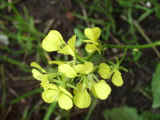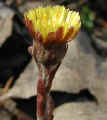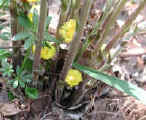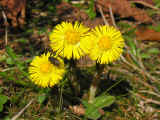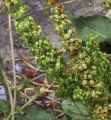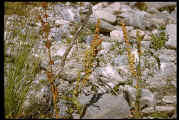|
Links
to Weeds>> |
Blackberry |
Campions |
Charlock |
Chickweed(Mouse-ear) |
| Chickweed |
Coltsfoot |
Dandelion |
Common
Dock |
Elderberry |
| Eucalyptus |
Grass
(Rye) |
Hawksbeards |
Hawthorn |
Ivy |
| Lettuce |
Meadowsweet |
Mountain
Ash |
Persicaria |
Plantain
(Ratstails) |
| Plantain
(Ribwort) |
Privet |
Ragwort |
Shepherd's
Purse |
Teazle |
| Thistle |
Watercress |
Willow |
w |
w |
BLACKBERRY (Bramble) (Rubus
fruticosus)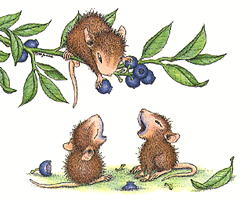
DID YOU KNOW?
Some people believe that when Satan was cast out of
heaven, he landed in a prickly Bramble Bush! For this reason, in some English
counties, the Bramble fruits are not picked after St. Michael's Day (29 Sept)
because the Devil curses them!
- One of the most useful fruits of early autumn. As soon as the berries show signs of ripening - around Aug.
- - the native
birds begin their annual feast!
- Wild birds : Bullfinches, Hawfinches, Blackbirds and lots of other
song birds relish them.
- Most cage and Aviary birds love them, even Canaries.
- Softbills, thrive on them.
- Blackberries contain a medicinal property that has a marked astringent
action.
- They are an excellent stomach tonic for birds.
- They are of great value, when ripe, as a safe colour-food.
- To help the quality and colour of the plumage at moulting time.
- It's rich in vit. C. (As the "Ribena" manufacturers tell us!)
- They can frequently have fruits of 4 different stages of maturity on the
same spray.
- Green > red >
red-purple > Black
- The Blackberry bush, is often called the 'Bramble', because of the way it
grows.
- > weaving its way through other plants and trees.
- Farmers used to plant Blackberry in amongst Hawthorn hedges.
- This helped to bind the Hawthorn together and make a stronger barrier.
- The tough stems of the Blackberry are armed with hooked thorns which serve
two purposes.
- They deter grazing animals from eating them.
They also help to support the plant by latching onto other vegetation as
it grows.
^Go
to Top
CAMPIONS (Lychnis)
-
Campions are a great favourite with many of our native
Finches.
-
Their seeds are greedily eaten by :
Campions are a close relative to the Chickweed
-
altho they
are of no use as a green-food
-
The seeds have similar nutritional values as Chickweeds.
-
Their Seed Capsules are unusually large and abundant.
-
The Best known Campion and most useful is the White or
Evening Campion.
-
So called becos it's pure White blossoms open and
become fragrant towards dusk.
-
The White species is found in ploughed fields, where
it often towers above other plants and the crop itself.
-
The Stems can reach approx 2ft high.
-
The leaves on the lower parts may be as long as 5 - 6"
-
The upper leaves are only about 3"
-
They always grow in opposite pairs.
-
They are rather narrow and pointed + hairy.
-
During the sunny part of the day the flowers often remain
closed
-
They tend to open towards dusk and are even open during
night-time.
-
When they have almost luminous properties.
-
The Red Campion differs only in colour.
-
Found mainly in hedge-banks and dampish woodlands.
-
There are male and female plants
-
There is very little difference to the eye
-
But only the Female plants produce the Seed
-
The Male plants merely drop away after flowering without
leaving any capsules.
^Go
to Top
CHARLOCK (Brassica Sinapis)
-
Charlock is one of the most abundant of British Weeds.
-
It grows mainly in cornfields and ploughed land.
-
It is very closely related to the cultivated Mustard.
-
Both Charlock and Mustard seeds are very similar in their
properties
-
Charlock seeds are smaller and much darker than mustard
seeds.
-
The seeds are a great favourite with wild birds
-
Charlock seeds are good to create "heat" and
therefore are beneficial during cold weather.
-
They can help keep asthma and chills and related symptoms at
bay when the weather is bad.
-
The Charlock plant has branched stems
-
They reach a height of 1 - 2 ft.
-
The flowers are bright yellow and about 1 - 2" across
when fully open.
-
Seed pods are approx. 2" long, Squarish or angular with
an awl-shaped beak at the top.
^Go
to Top
CHICKWEED (Stellaria Media)
|
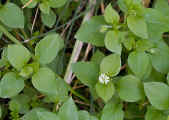 |
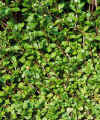 |
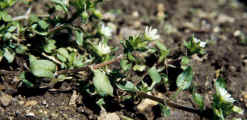 |
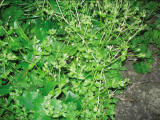 |
|
Close-up of Chickweed Plant |
|
Clumps of Chickweed |
|
- This is a name given to many plants, some of which
are not really Chickweeds at all.
- The true CHICKWEED (Stellaria Media) is
one of the very best of all our wild green-foods.
- You may use it at any stage of it's growth-life.
- When it is mature it is a favourite food with most
hen-birds for their nestlings.
- Almost all our British Birds love it
:
- Goldfinch; Greenfinch; Chaffinch; Bullfinch and
Linnet all eat it as do Blackbirds, Skylarks and Yellow Buntings.
- The green leaves and shoots are rich in vital
vitamins & minerals, incl. iron, which are essential for good health.
- The seeds are also edible.
- The plant can be dried for storage.
- Chickweed
Vitamins & Minerals :
- Vit. C : It is particularly high in ascorbic acid
and mucilage properties.
- B. Vits : Niacin (B3), riboflavin (B2), thiamin (B1),
- Vit A : Beta carotene
- Minerals
: magnesium, iron, calcium, potassium, zinc,
phosphorus, manganese, sodium, selenium, and silicon.
- Medicinally,
Chickweed is useful (for
both Birds and Humans) as :
- Chickweed is delicious and fresh-tasting, as a salad
"vegetable" for us humans.
- Properties include :
- A tonic, diuretic, demulcent,
expectorant, and mildly laxative.
- It's often recommended for asthma, bronchitis, or congestion.
- It's also said to help control obesity and is an ingredient in some
human herbal weight loss preparations.
- Externally, chickweed relieves itching and inflammation and is
generally soothing and moisturizing.
- It can be used for any minor skin infections or irritations, and is an
ingredient in a number of commercial skin care products.
- Common chickweed is a very common weed.
- It is extremely variable in its appearance, but generally it has a
very slender tap root and greatly branching leafy stems, which lie along
the ground.
- Many small, white flowers are produced; the stamens have
reddish-violet anthers.
- Chickweed is just about always flowering, except in the dead of
winter.
- The flowers close at night and open in the morning.
- They also close when it's about to rain.
- Possibly they respond to changes in air pressure.
- It does seem that the flowers don't open at all when a low
pressure system is lingering.
- Chickweed also reacts to nightfall by folding its leaves over the
growing tip to protect it.
^Go
to Top
COLTSFOOT (Tussilago Farfara)
- Coltsfoot is one of the earliest of all our Spring Flowers.
- They are about 4 inches high at first growth.
- The yellow flowering heads are often to be seen before the end of January.
- March is the main month of growth though.
- Coltsfoot grows abundantly on moist and heavy soils.
- They look like a smaller relation to the dandelion flower.
- They differ from the Dandelion by their scaley stalks and smaller
flowering heads.
- When the flowers have withered, the heads droop down and remain in that
position until the seeds are ripe.
- They they become erect again and often grow to a foot or more in height,
until finally opening into a globular ball of silvery pappus, which is
eagerly sought by many birds as a lining for their nests.
-
In the
photo
above we get a good comparison of the size difference
between the first flower stage (4" approx) and second (seeding head
stage) of growth (approx 1ft).
-
Coltsfoot is a Food and a medicine
combined (Both Birds & Humans)
- It is one of the finest of all natural remedies for any trace of Wheeziness
or Asthma.
- Improvement which follows its use is often fairly obvious.
- Wild Birds seem to relish the flowering heads - esp. the Chaffinch.
-
The leaves of the coltsfoot were used as
an ingredient in herbal tobacco, which was smoked as a cure for asthma. (-
that's a bit of a contradiction in terms - inhaling smoke to help your
breathing - don't u think?!)
-
Coltsfoot tea, sweetened with honey, was
used for colds and asthma.
-
Even the flower stocks of the coltsfoot
were used to make "syrup of coltsfoot", which was recommended for
treating chronic bronchitis.
-
Birds do seem to eat the stems and
enjoy them.
^Go
to Top
DANDELION
:
(Taraxacum vulgare)
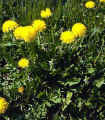
|

|
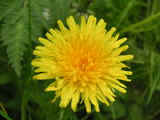
|
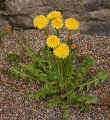
|
|
Dandelion
Flowering Heads |
The
Seeding Heads or "Dandelion Clocks" |
Dandelion
Close-up + growing on gravel |
-
The Dandelion may be found in bloom in almost any month of
the year.
-
It is probably at it's best in the Spring when the leaves
are young and tender.
-
It is generally conceded that the Dandelion is the best
"Blood Purifier" in Nature's medicine Chest.
|
There is hardly a finer tonic for your Birds,
amongst all
our English weeds.
Here's a pair of Fife Canaries enjoying young Dandelion leaves,
with
bits of Fresh, young, Spring Grass mixed in
- NOT LAWN
CLIPPINGS!
Click on picture to enlarge >>> |
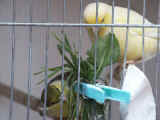
|
-
Birds Love these parts of the Dandelion :
-
Leaves, flowers.
-
and the seeding heads before they open out into
the "Dandelion Clock"
-
To Feed
: part the closed Seeding Head and if the
seeds are dark brown.
-
- cut off the white fluffy end bit .
-
Push the dandelion head, with the ripe seeds in between
the bars of your Birds' cage.
-
Canaries, in particular, love these seeds (fed as
above) and they are very good for them.
-
Not many people realize there are, in fact, over 300 similar
"Dandelion-like" plants
growing wild in this country.
-
The True Dandelion
(as
pictured above) is the only one, which has all the
wonderful nutritional and medicinal properties which are attributed to it.
The TRUE DANDELION's Description:
It has the familiar Yellow fronded flowering head.
A dandelion
flower
head consists of many tiny flowers.
It grows singly at the tops of bare and un-branched
stalks.
Each stalk is smooth and shiny
It is always hollow.
It exudes a bitterish milky juice as soon as the stem is
broken. The leaves always have the familiar backward-pointing
lobes.
it reproduces asexually Below ▼
are examples of plants that look like true dandelions but do not conform to the description above.
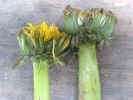
| 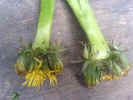
| 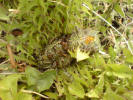 | These
2 ▲pseudo"Dandelions"have 3+flowering heads each on fat stems (click to enlarge pictures) |
It is
important to remember that those Dandelion-like weeds which bear 2 or more
flower-heads on a single or branched stalk, are NEVER proper Dandelions, no matter how much they may resemble them!
Similar plants are the Hawkweeds, Hawkbit and Hawks-beard
families.
OTHER USES FOR THE DANDELION
- Dandelion root
is a registered
drug in
Canada,
sold as a
diuretic
- (i.e. it relieves water retention - swollen ankles etc.)
- It helps to keep the kidneys in good working
order.
- A leaf decoction can be drunk to "purify the blood"
- for the treatment of anemia, jaundice, and also for nervousness.
- The milk is also applied to warts,
- helping get rid of them without damaging the surrounding skin.
- The milky latex has been used as a mosquito repellent.
COMMON DOCK (Curled) : (Rumex
Crispus)
-
This is one of the very worst weeds for the British Farmer
to try and eradicate.
-
But what is the Farmer's Pest is loved by most birds.
-
Wild Birds come from far and wide to enjoy feasts of the Dock Seed - The Bullfinch in particular.
-
Most Cage birds inc. Canaries and most Finches relish the
Dock Seeds.
-
Some Breeders claim that no other seed has such a good
effect upon the plumage.
-
The Dock seeds contain quite a high percentage of oils.
-
This makes it a good Winter food for maintaining
condition and helping to prevent chills.
-
Even though the seeds seem to have a high oil content they
tend not to cause undue fatness.
-
In fact, the effect seems to be the reverse.
-
The bowels are kept in such a healthy condition that
there is no obvious accumulation of fat.
-
For this reason, the Dock seed has often been used as an
aid to help correct obesity.
-
This oil also serves as an internal lubricant and helps
keeps the digestive tract in order.
-
The Dock seed is easy to gather in quantity.
-
The seeding heads can be dried, just as they are, to be fed
throughout winter.
-
Plants are tall and have strong stems, which are difficult
to cut/strim thru.
The only way the land-owner can get rid of the Dock is to
spray with a strong systemic Weed killer, which is absorbed into the
root-system and kills the whole plant.
EUCALYPTUS TREE / Leaves
-
Parrot-like birds, inc. Budgies and other small parakeets love Eucalyptus
leaves.
-
Galahs use them in the wild to line their Nests.
-
The leaves contain a natural
insecticidal deterrent.
-
They are supposed to help deter mites and mice!
WILLOW TREE
-
A Willow cutting can grow massively over a short period of time.
-
Most birds love these leaves.
-
and enjoy stripping the bark off the twiglets the leaves
grow on.
-
Esp. in early spring when the buds, new leaves and baby
catkins are starting to develop.
-
They
will also strip and chew the fine stems/branches that you put in with them.
-
Willow contains “Salicylic acid” which is the main
ingredient in Aspirin
-
— so it has medicinal properties.
-
If you have room in
your garden, you can strike a Willow cutting very
easily,
-
by breaking a piece
off the desired tree (approx 1” diameter is ideal)
-
then plant the cut end 3
— 4” into the soil.
-
It should strike and start to grow by spring but beware,
- they do grow alarmingly quickly.
^
Go to Top
 |
